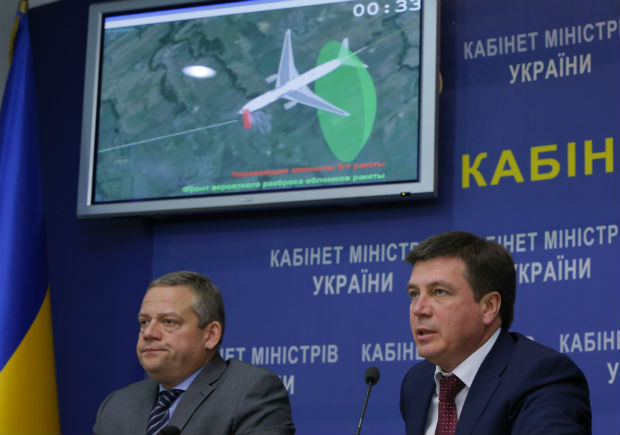
Vice Prime Minister and chairman of the government commission to investigate the causes of the MH17 crash Hennadiy Zubko, right, speaks at a briefing for journalists in Kiev, Ukraine, Tuesday, Oct. 13, 2015. Investigators said the Buk missile that downed Malaysia Airlines Flight 17 exploded less than a meter from the cockpit, killing the two pilots and the purser inside in an instant and breaking off the front of the plane. AP
One of the last things that passengers of Malaysia Airlines Flight MH17 likely heard was the detonation of the missile that took down their plane.
The Dutch Safety Board (DSB) said that a pressure wave caused by the exploding warhead led to a “deafening” sound.
“This loud and abnormal sound must have been audible to everyone on board,” according to a section of the report by DSB.
Unveiling a final report over the crash at the Gilze-Rijen military base Tuesday, DSB head Tjibbe Joustra said a warhead fired by a Russian-made Buk missile system downed MH17 on Jul 17 2014, which led to the deaths of 298 people on board.
Missile fragments from the warhead struck the cockpit, killing its three crew members instantly.
These fragments were not found in the bodies of the other people in the plane. The report does not say if they too died instantly.
However, it suggests that they may have suffered very serious injuries and soon lost consciousness before their deaths.
Those on board were suddenly exposed to an airflow of 900kph, according to the report.
The DSB said Hurricane Katrina in 2005 – one of the US’ most powerful hurricanes recorded – had an airflow of 282kph.
The strength of this airflow would have been strongest at MH17’s “fracture edges”, the report said, with a smaller presence at the plane’s rear.
Passengers were exposed to MH17’s sudden deceleration and acceleration as the plane fell down after its front part came off.
They also suffered from a sudden drop in air pressure and a lack of oxygen at an altitude of about 33,000 feet.
“At an altitude of nine to 10km, the lack of oxygen leads to unconsciousness within 30 seconds to one minute,” the report said.
The combined factors suggested that the sudden loss of cabin pressure could have led to serious internal injuries.
Those not strapped into their seats would have suffered a higher chance of injury than those who did, as they could have been hit by flying luggage and parts of the plane.
The report said passengers’ bodies were likely shocked by the sudden extreme changes in temperature when MH17 broke up, exposing them to airs as cold as -40°C.
Ultimately, the report said “regardless of the exact speed,” none of those falling to the ground would have survived.
RELATED STORIES
Families brace for final MH17 air crash report
MH17 investigators find ‘possible’ Russian missile fragments